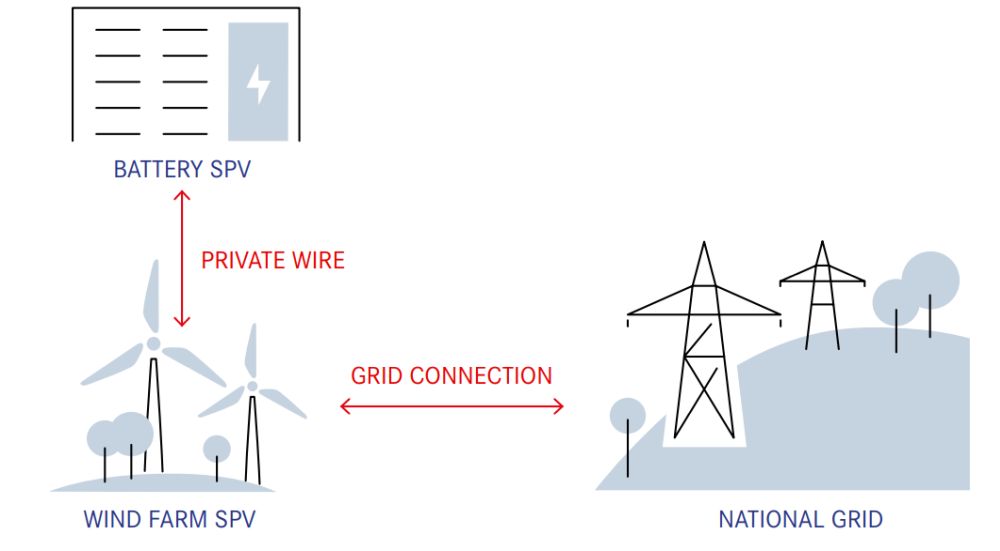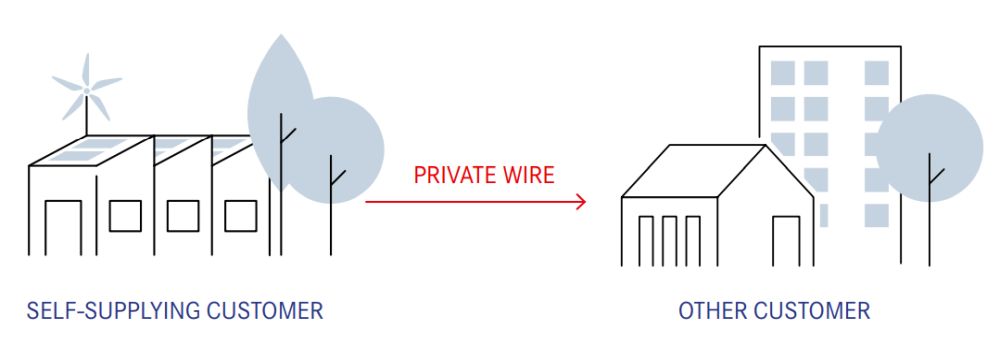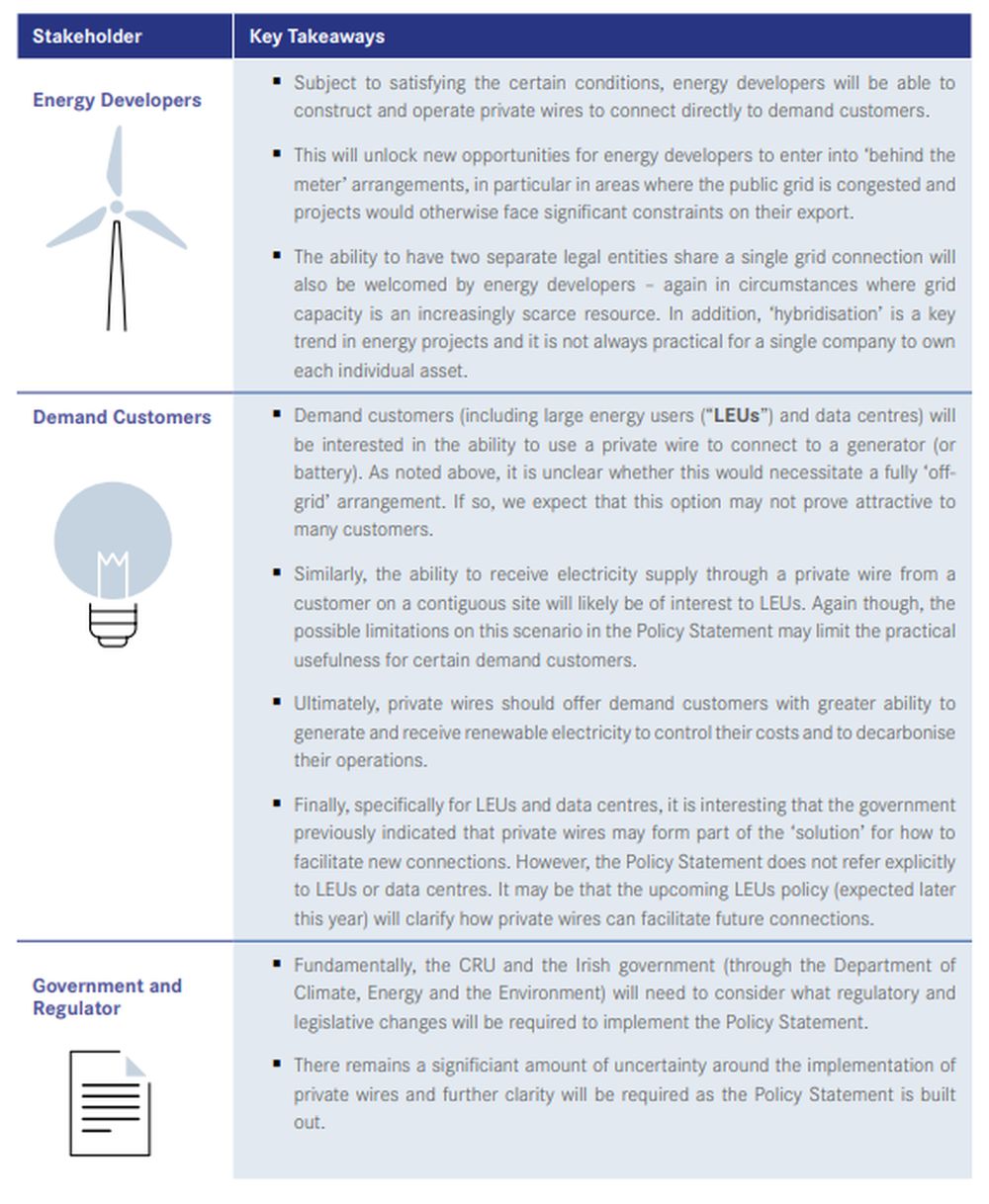- within Energy and Natural Resources topic(s)
- in United States
- in United States
- within Media, Telecoms, IT, Entertainment, Compliance and International Law topic(s)
BACKGROUND
On 15 July 2025, the Irish government published its Private Wires Policy Statement (the "Policy Statement"), marking a significant step in reforming the Irish electricity sector.
The Policy Statement supports the development of a framework for private companies to build, operate and own electricity lines (ie, "private wires").
It is worth noting, at the outset, that the Policy Statement is just that. The measures that will actually give effect to this policy (eg, legislative amendments) have not yet been developed and it is only when they are available that the policy can be assessed in meaningful detail.
In the meantime, this update:
- summarises the Policy Statement (including the key regulatory conditions associated with constructing / owning a private wire);
- identifies the key considerations of the Policy Statement for industry stakeholders; and
- highlights next steps and implementation items.
EXECUTIVE SUMMARY
- Subject to certain conditions, private entities will be permitted to construct, own and operate electricity lines in certain scenarios, unlocking opportunities for both energy developers and demand customers alike.
- Private wires will be permitted to (1) connect a single generator to a single customer, (2) allow multiple legal entities (eg, a wind farm SPV and a battery SPV) to share a grid connection, (3) facilitate on-street electric vehicle parking, and (4) expand the ability of self-supplying customers to onward supply electricity to adjacent customers.
- Further details are awaited on the implementing measures and the Policy Statement indicates the potential for future public consultation (although no timing is specified). In the meantime, while the scenarios in the Policy Statement are limited in scope, the policy will be seen by industry as a significant step in the right direction.
PERMITTED SCENARIOS
The Policy Statement will facilitate the construction and operation of private wires in four specific scenarios. These four scenarios are set out below.
In each of these scenarios, the Policy Statement suggests that a private wire must be (1) the most efficient approach to a new connection and (2) in the public interest.
Scenario 1: Private Lines from a Generator to a Customer

This scenario allows for a private wire to directly connect a single generator (which includes battery storage) to a customer or other electricity undertaking.
Customers will need to obtain permission from the Commission for Regulation of Utilities ("CRU") to develop any such private wire. The CRU will ensure that:
- The project aligns with, and serves, broader policy objectives such as, security of supply, the offshore wind strategy and other national climate objectives.
- A more cost-effective, grid-based solution, is not available to the customer within a reasonable period of time.
- The system operators (ie, EirGrid and ESB Networks) can recover the costs of the services they have contracted to provide to the customer (including any revised tariffs, if necessary).
- The private wire must meet the same technical and safety standards as the national electricity grid (ie, in line with EirGrid / ESB Network's standards), and will be capable of being taken in charge by the system operators.
From our reading of the Policy Statement:
- It is not clear exactly how the 'cost effectiveness' test will be applied in practice. It is worth noting though that EU law requires the criteria for granting an authorisation to construct a private wire to be objective and non-discriminatory.
- It is also not fully clear if the above scenario assumes a fully 'off-grid' model or if one (or both) customers could have a public grid connection in addition to a private wire.
We expect that these issues will be clarified in due course by, among other things, legislative amendments.
Scenario 2: Hybrid Connections

This scenario refers to cases where two companies (eg, a wind farm SPV and a battery storage SPV) share a single grid connection. This option builds on the Government's pledge to "ensure that hybrid technology grid connections are facilitated, and remaining barriers removed" under the Climate Action Plan 2023.
The Policy Statement notes that the CRU is exploring the legal / regulatory changes required to allow multiple entities to share a grid connection through a private wire.
Scenario 3: On Street Electric Vehicle Charging
 /p>
/p>
The Policy Statement supports the use of private wires to facilitate the development and deployment of public and private electric vehicle (EV) charging infrastructure – noting the national target that 30% of all private vehicles will be EVs by 2030.
The Policy Statement notes that existing legislation will be clarified, and highlights the potential for private wires to be permitted to be used in public or shared spaces to facilitate the development of additional EV charging infrastructure.
Scenario 4: Expansion of Self Supply

This scenario envisages using private wires to expand existing rules governing self-supply.
Under the existing regulatory regime, a customer is allowed to generate electricity behind the meter for its own use / consumption on a single premises because this does not involve any electricity 'distribution' or 'transmission'.
Subject to safety and technical safeguards, the Policy Statement indicates that private wires could be used to allow a customer who generates electricity for self-supply to provide electricity to a separate customer on a contiguous site.
From our reading of the Policy Statement:
- The wording of this scenario is not entirely clear. On a strict reading, it would require there to be two demand customers – one of whom generates and consumes power, and who then supplies some of this power to another customer. This would appear to preclude that first customer being a generator (ie, no demand / consumption) but it is unclear if this is an intentional limitation or not.
- Similarly, the reference to a 'contiguous' site suggests that the second customer must be on an immediately adjacent (ie, touching) site. This would appear to preclude a private wire connecting two nearby, but non-contiguous, sites. Again, it is unclear if this is an intentional limitation or not.
Again, we expect that the implementing measures will clarify the position on these two items.
KEY STAKEHOLDER TAKEAWAYS
Whilst there remains a degree of uncertainty around the details of the private wire framework (while we await legislative and regulatory changes), the Policy Statement represents a significant step for the development of electricity infrastructure in Ireland.
We have summarised key takeaways for certain stakeholders below.

NEXT STEPS AND TIMELINE
The Policy Statement outlines several critical areas requiring updates to enable successful implementation. These include:
- introducing primary legislation to amend the Electricity Regulation Act 1999 to allow for private wires;
- supporting regulations to define standards and processes for granting permission for private wires;
- providing additional resources to the CRU to allow for adequate oversight of private wires; and
- continuing to monitor industry developments to refine the Policy Statement.
The Policy Statement notes that public consultation responses recommended a further round of engagement prior to the implementation of this policy which may be necessary to further refine the approach and ensure alignment with stakeholder needs. The Policy Statement does not clarify when such public consultation might take place.
The content of this article is intended to provide a general guide to the subject matter. Specialist advice should be sought about your specific circumstances.
[View Source]



